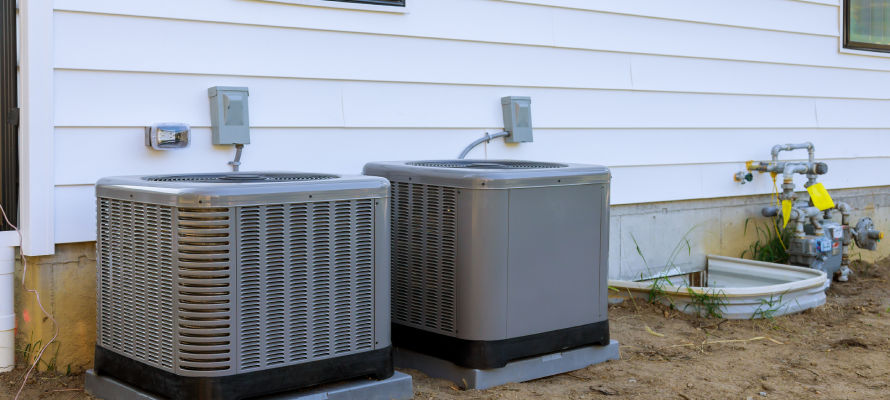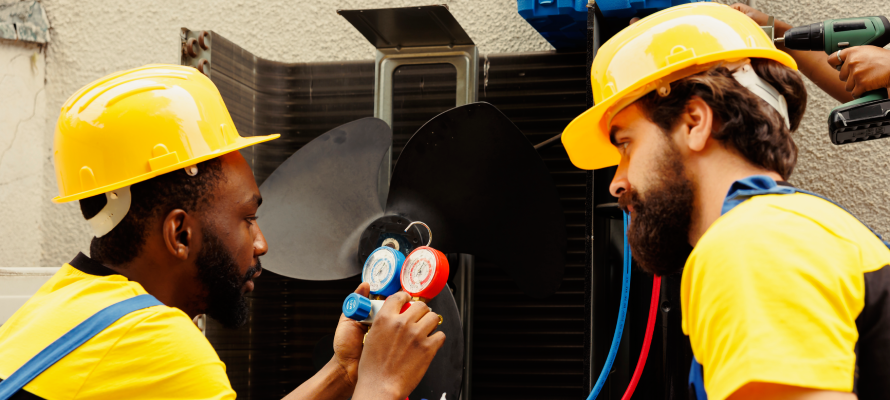Table of Contents
Most HVAC contractors are terrible at marketing. They know how to fix a furnace or install a new AC unit, but when it comes to getting customers through the door? That’s where things fall apart.
Here’s the brutal truth: 90% of homeowners start their search online now. Your competitor down the street probably figured this out already while you’re still waiting for the phone to ring. The good news? You can catch up fast if you know which strategies actually work.
I’ve watched hundreds of HVAC businesses transform their lead generation by focusing on the right mix of digital and traditional marketing. Some marketing strategies for growing your HVAC business will surprise you (direct mail still crushes it in certain neighborhoods), while others are absolutely non-negotiable in 2025.
Let’s dive into 15 strategies that actually generate customers instead of just burning through your marketing budget.
Why Most HVAC Marketing Fails
Before jumping into tactics, you need to understand why most HVAC companies waste money on marketing. The biggest mistake? Treating all customers the same. Your emergency repair customers think differently than people planning a system replacement. Your commercial clients have completely different priorities than residential homeowners.
Smart HVAC businesses allocate 5-8% of revenue to marketing. New companies should probably push that higher; established businesses can sometimes get away with less if their referral network is strong. The key is measuring everything. If you can’t track where your leads come from, you’re flying blind.

Digital Strategies That Actually Work
1. Master Local SEO (It's Not What You Think)
Everyone talks about SEO, but most HVAC contractors do it wrong. They stuff keywords into blog posts and hope Google notices. That’s amateur hour.
Real local SEO starts with your Google Business Profile. Complete every single field. Upload photos of your trucks, your team, actual work you’ve done.
When someone searches “HVAC repair near me,” Google shows businesses with complete, active profiles first.
Here’s what actually moves the needle:
1. Write service pages for every town you serve (not just one generic page)
2. Get reviews consistently, not in random bursts
that look fake
3. Answer questions people actually ask Google about HVAC systems
4. Create content around seasonal problems your
customers face
5. Make sure your website loads fast on
mobile devices
Skip the generic “HVAC tips” blog posts. Instead, write about specific problems in your area. If you’re in Phoenix, write about AC units struggling in 120-degree heat. If you’re in Minnesota, focus on heating systems failing in sub-zero weather.
The technical stuff matters too. Your website needs to load in under 3 seconds, especially on phones. Google punishes slow sites, and impatient customers will bounce to your competitors.
2. Google Business Profile: Your Digital Storefront
Your Google Business Profile is probably your most valuable marketing asset, yet most contractors treat it like an afterthought. This is where customers first judge your business, and first impressions stick.
Start with the basics: correct address, phone number, and hours. Sounds simple, but you’d be shocked how many businesses get this wrong. One digit off in your phone number costs you calls.
Photos sell jobs. Upload pictures of your team at work, your service vehicles, before and after shots of installations. Avoid stock photos; customers can spot them immediately. Real photos build trust.
Reviews are your reputation. Five-star businesses get more calls than three-star businesses, even if the three-star company has better prices. Actively ask satisfied customers for reviews, but do it naturally. A text message the day after a successful service call works better than pushy in-person requests.
Respond to every review, good and bad. Thank customers for positive feedback. Address complaints professionally without getting defensive. Other potential customers are watching how you handle problems.
3. Google Local Services Ads: Premium Real Estate
Google Local Services Ads sit at the very top of search results, above everything else. For emergency HVAC situations, this premium placement can make the difference between getting the call or watching it go to someone else.
The Google Guarantee badge builds instant trust. Google has verified your licensing, insurance, and background checks. Customers feel safer choosing guaranteed businesses, especially for emergency services.
You only pay when customers actually contact you, not when they just see your ad. This makes budgeting more predictable than traditional pay-per-click advertising. A plumbing company in our network typically sees 30-40% lower cost per lead compared to regular Google Ads.
Keep your profile updated and respond quickly to inquiries. Google tracks response times and adjusts your visibility accordingly. Slow responders get buried; fast responders get more opportunities.
4. Google Ads That Actually Convert
Google Ads can drain your budget fast if you don’t know what you’re doing. The secret is understanding customer intent. Someone searching “emergency furnace repair” has very different needs than someone searching “best HVAC companies.”
Focus on problems, not products. “Furnace won’t turn on” gets better results than “furnace repair” because it matches how panicked customers actually search. Emergency keywords typically cost more but convert at higher rates.
Use ad extensions liberally. Add your phone number, location, and service highlights. These make your ads larger and more prominent. A bigger ad gets more clicks, assuming your copy is compelling.
Geographic targeting saves money. Only show ads to people in your service area. Sounds obvious, but plenty of contractors waste budget on clicks from customers they can’t serve.
Set up conversion tracking to see which keywords actually generate customers, not just website visitors. A keyword might bring lots of traffic but zero phone calls. Cut those keywords and reinvest in what works. This level of HVAC PPC optimization separates profitable campaigns from money pits.
5. Your Website: First Impressions Matter
Most HVAC websites look like they were built in 2005. Outdated design screams “outdated business” to potential customers. You don’t need fancy graphics, but you do need clean, professional design that works on mobile devices.
Make your phone number impossible to miss. Put it in the header, footer, and multiple spots throughout the site. When someone’s furnace dies at 11 PM, they want to call immediately, not hunt for your contact info.
Include real customer reviews and photos of your actual work. Stock photos of generic technicians don’t build trust. Pictures of your team and real projects in your area do.
Speed matters more than fancy features. A slow-loading website kills more sales than bad design. Test your site speed on mobile devices; that’s how most people will find you.
6. Managing Your Online Reputation
Online reviews drive customer decisions more than any advertisement you’ll ever run. The difference between 4.2 stars and 4.7 stars can double your phone calls from Google searches.
Ask for reviews systematically, not randomly. Send a text message 24-48 hours after completing a job while the positive experience is fresh. Don’t ask during the service call; customers feel pressured and reviews often come across as forced.
Bad reviews happen. How you handle them separates professional businesses from amateurs. Respond quickly, take responsibility where appropriate, and explain how you’ve addressed the issue. Future customers judge your business by how you handle complaints.
Monitor mentions of your business across the web, not just Google and Facebook. Set up Google Alerts for your company name to catch discussions on neighborhood forums, Next-door, and other local platforms.
7. Social Media: Skip the Fluff
Most HVAC companies waste time on social media because they treat it like traditional advertising. Social platforms reward engagement, not sales pitches.
Share content that actually helps people. Photos of complex installations, simple maintenance tips, and explanations of common problems perform better than promotional posts about your services.
Facebook works well for residential customers; LinkedIn targets commercial clients. Don’t spread yourself thin trying to be active on every platform. Pick one or two and do them well.
Engage with your local community online. Comment on local business posts, share community events, and participate in neighborhood groups (without being salesy). This builds relationships that generate referrals.
8. Content Marketing That Generates Leads
Blogging for the sake of blogging is pointless. Every piece of content should either educate customers or capture leads from people with immediate needs.
Write about seasonal issues before they become problems. Publish heating system maintenance tips in October, not January when systems are already failing. This positions you as proactive rather than reactive.
Video content outperforms written content for HVAC topics. People want to see how systems work, not read technical explanations. Short, helpful videos on common problems can generate leads for months.
Create downloadable guides for major purchases like system replacements. A “Complete Guide to Choosing a New Furnace” captures contact information from serious prospects.
9. Email Marketing: The Relationship Builder
Email marketing delivers the highest ROI of any digital marketing channel, but most HVAC companies do it wrong. They send generic newsletters nobody wants to read instead of useful information customers actually value.
Segment your list by customer type and service history. Commercial clients don’t care about residential promotions. Emergency repair customers have different needs than maintenance plan subscribers.
Send these types of emails regularly:
1. Seasonal maintenance reminders
based on equipment age
2. Energy efficiency tips that help
customers save money
3. Safety alerts about carbon monoxide,
electrical issues, etc.
4. Special offers for loyal
customers only
5. Educational content about new technology
and rebates
Automate follow-up sequences after service calls. A simple “How did we do?” email 48 hours after service completion shows you care about quality and often generates reviews or referrals.
Time seasonal campaigns carefully. Send AC tune-up promotions in March, not July when systems are already running constantly. Early bird pricing works because customers save money and you can schedule work during slower periods.

Traditional Strategies That Still Work
10. Direct Mail: The Comeback Kid
Everyone declared direct mail dead, but smart HVAC contractors are quietly using it to dominate their neighborhoods. While competitors fight over Google clicks, direct mail lands on kitchen tables with zero competition.
Target specific neighborhoods strategically. Focus on areas with homes built 15-25 years ago; that’s when major systems start needing replacement. Avoid new construction areas and very old neighborhoods where homeowners might not have maintenance budgets.
Make your mailers stand out without looking cheap. Postcards work better than letters because people don’t have to open them. Include a compelling offer that expires soon; urgency drives action.
Track results with unique phone numbers or promo codes. Direct mail typically takes 3-6 exposures before customers respond, so plan campaigns with multiple touchpoints rather than one-and-done mailings.
11. Community Involvement: Playing the Long Game
Sponsoring local youth sports teams or community events builds name recognition that pays off for years. When someone needs HVAC service, they remember businesses that support their community.
Partner with complementary businesses like general contractors, electricians, and plumbers. These relationships generate qualified referrals because customers often need multiple services during home renovations.
Host educational seminars about energy efficiency, indoor air quality, or seasonal maintenance. Libraries and community centers often provide free venues for these events. Attendees are pre-qualified prospects interested in HVAC topics.
Join your local Chamber of Commerce and actually participate. Show up to networking events, sponsor activities, and build real relationships. Membership directories and referrals from other members can generate significant business.
12. Referral Programs: Turning Customers into Salespeople
Happy customers will refer friends and family if you make it easy and worthwhile. Most HVAC companies rely on word-of-mouth but don’t actively encourage it.
Create a formal referral program with clear rewards. Cash works better than discounts for most customers. A $100 bill feels more valuable than $100 off their next service call.
Train your technicians to recognize referral opportunities during service calls. When customers express satisfaction with the work, techs should mention the referral program naturally as part of the conversation.
Essential elements of technician training include:
1. Professional appearance and
punctuality standards
2. Clear communication about services
and recommendations
3. Proper cleanup and respect for
customer property
4. Honest pricing without hidden fees or
surprise charges
5. Follow-up procedures to ensure
customer satisfaction
Make it easy for customers to refer others. Provide referral cards with your contact information and the reward details. Digital referral links for social media sharing work well for tech-savvy customers.
Follow up quickly when referrals call. Mention who referred them and provide excellent service; your reputation with the referring customer depends on how you treat their friends.

Advanced Tools and Technology
13. Call Tracking: Know Where Your Money Goes
Most HVAC companies have no idea which marketing generates actual phone calls. They spend thousands on Google Ads, radio spots, and Yellow Pages without knowing what works.
Use different phone numbers for each marketing channel. Your website gets one number, Google Ads get another, direct mail gets a third. This simple change reveals which investments generate calls and which waste money.
Call recording helps train staff and improve conversion rates. Listen to calls from customers who didn’t schedule service; you’ll discover why prospects choose competitors instead of your business.
ServiceTitan’s Marketing Pro integrates call tracking with customer management, providing complete visibility from first contact through final payment. This level of insight helps optimize marketing spend and improve sales processes.
14. Lead Management: Don't Let Opportunities Slip Away
Speed kills in HVAC sales. Customers with emergency needs call multiple companies and choose whoever responds first. A lead management system ensures no opportunity falls through the cracks.
Score leads based on urgency and value. Emergency repairs get immediate attention; routine maintenance requests can wait a few hours. System replacement inquiries deserve your best salesperson, not whoever answered the phone.
Follow up on unsold estimates aggressively. These customers already expressed interest and got pricing; they’re much more likely to buy than cold prospects. Automated email sequences can nurture these warm leads until they’re ready to move forward.
15. Analytics: Measure What Matters
Track metrics that directly impact revenue, not vanity numbers like website visitors or social media followers. Cost per lead, conversion rates, and customer lifetime value tell you whether your marketing actually generates profit.
Google Analytics reveals which website pages generate leads and where visitors come from geographically. This information helps optimize content and identify successful marketing channels.
Review performance monthly, not quarterly. HVAC demand changes seasonally, and what works in summer might fail in winter. Regular analysis allows quick adjustments to maximize seasonal opportunities.
Set up dashboards that show key metrics at a glance. Revenue per marketing channel, lead conversion rates, and customer acquisition costs help make informed decisions about budget allocation.
Building Your Marketing Plan
Most HVAC contractors try to do everything at once and end up doing nothing well. Start with three strategies maximum; master those before adding more.
New businesses should prioritize Google Local Services Ads and Google Business Profile optimization for immediate visibility. Established companies might focus on SEO and referral programs for long-term growth.
Budget 6-10% of revenue for marketing if you want aggressive growth. Mature businesses can often maintain market share with 3-5% investment. Track ROI religiously; any marketing that doesn’t generate profitable customers should be eliminated.
Plan seasonally. AC marketing starts in March, heating promotions begin in September. Indoor air quality campaigns work year-round but peak during allergy seasons.
The Reality Check
Here’s what nobody tells you about HVAC marketing: consistency beats creativity every time. A simple Google Ads campaign running every day generates more leads than a brilliant social media campaign that runs for two weeks then gets forgotten.
Most contractors quit marketing strategies before they have time to work. SEO takes 6-12 months to show results. Referral programs need time to build momentum. Direct mail requires multiple exposures before customers respond.
The businesses that dominate their markets aren’t necessarily the most skilled technicians. They’re the ones who figured out marketing and committed to doing it consistently, even when immediate results weren’t obvious.
Your customers need HVAC services whether you market to them or not. The question is whether they’ll call you or your competitor who’s been showing up consistently in their search results, mailboxes, and community events.
Stop waiting for the phone to ring. Start implementing these strategies today, measure what works, and double down on success. Your future customers are searching for you right now.
Ready to Dominate Your Local HVAC Market?
At Helium SEO, we’ve helped hundreds of HVAC contractors transform their marketing from expense into profit center. We’re not your typical HVAC digital marketing agency that promises everything and delivers fluff. We’re engineers who happen to understand marketing, which means we focus on what actually generates revenue.
Our data-driven approach combines the digital strategies that work (Google Local Services, SEO, PPC) with traditional methods that still deliver results in your specific market. We track every lead, measure every campaign, and optimize for one thing: more qualified customers calling your business.
We work exclusively with home service contractors because we understand your industry. Emergency calls, seasonal fluctuations, local competition; we’ve seen it all and know how to navigate these challenges to build sustainable growth.
Ready to stop competing on price and start dominating your market? Let’s talk about building a marketing system that actually works for your HVAC business.
Quick Takeaways
- Capture urgent “AC repair near me” searches for instant leads.
- Optimize keywords, ads, and landing pages for high Quality Scores.
- Use negative keywords to cut wasted spend.
- Separate residential vs. commercial campaigns.
- Keep landing pages short, mobile, and CTA-focused.
- Use remarketing and cross-platform ads for more leads.
- Track ROI by revenue, not just clicks.
- Partner with Helium SEO for data-driven, seasonal HVAC PPC results.
Turn HVAC Searches Into Service Calls
Turn local searches into steady service requests with SEO built for heating & cooling companies.
Schedule a CallFAQs
How to promote your HVAC business?
To promote your HVAC business effectively, create a robust online presence through a professional website and active social media accounts, showcasing your services, customer testimonials, and case studies. Additionally, invest in local SEO strategies to ensure your business appears at the top of search results when potential customers in your area are looking for HVAC services. Networking with local contractors and real estate professionals, as well as leveraging traditional marketing techniques like direct mail and community sponsorships, can also significantly increase your visibility and attract new customers.
How to boost HVAC sales?
To boost HVAC sales, it’s crucial to focus on building strong relationships with customers through exceptional after-sales service and support. Additionally, implementing targeted marketing strategies, such as digital advertising specific to homeowners’ needs and seasonal promotions, can effectively attract new customers and retain existing ones. Offering flexible financing options, energy-efficient products, and educating customers on the long-term savings and benefits of new HVAC systems are all effective strategies for increasing sales.
How to find customers for HVAC?
To find customers for HVAC services, focus on digital marketing through platforms like Facebook, Instagram, and Google Ads to target homeowners or businesses in need of heating and cooling solutions. Additionally, building partnerships with local contractors, real estate agents, and property management companies can provide a steady stream of referrals. Implementing SEO strategies on your website to appear in search results for HVAC-related queries in your area is also crucial.






